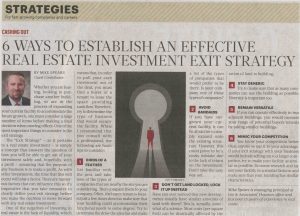6 Ways to Establish an Effective Real Estate Investment Exit Strategy
Whether you are leasing, looking to purchase another building, or are in the process of expanding your current facility to accommodate the future growth, one must consider a large number of items before making a final decision. One of the most important things to consider is the exit strategy.
The “Exit Strategy” – as it pertains to a real estate investment – is simply a concept that answers the question of how you will be able to get out of your investment safely and, hopefully, with a profit – assuming that the purpose of any business is to make a profit. As with other investments, the time that this will occur will play a factor. There are numerous factors that can influence this so it’s imperative that you take measures to clearly define your exit strategy before you make the decision to move forward with any real estate investment.
One of the negatives of investing in real estate is the lack of liquidity, which means that, in order to pull your cash investment out of the deal, you must find a buyer or a tenant to lease the space providing cash flow. Therefore, try to determine the type of business that would occupy the facility. While I recommend that you consult with a professional, the following are basic tips to consider:
- BIRDS OF A FEATHER: Get familiar with the area and take note of the types of companies that are nearby the site you are considering. Then compare them to your site. Often, the buyer/tenant is located just a few doors down so make sure that your building could accommodate their functional needs to some degree. Try to determine the “draw” to the area and make a list of the types of companies that would prefer to be there.
- AVOID BANDAIDS: If you have outgrown your current facility, it can be attractive to simply expand onto the existing structure. However, this could prove to be a costly mistake due to the lack of return on the investment.
- DON’T GET LAND LOCKED, LOCK IT UP INSTEAD: Have you ever noticed that new developments usually have similar amounts of land with them? This is, actually, somewhat of a science. Most costs (per square foot) can be drastically affected by the ration of land to building.
- STAY GENERIC: Try to make sure that as many companies can use the building as possible. Diversity is important too.
- REMAIN VERSATILE: If you can operate effectively in two adjacent buildings, you would increase your range of potential buyers/tenants by taking smaller buildings.
- MIMIC YOUR COMPETITION: You know your competition better than anyone so use it to your advantage. If your exit strategy with your business would include selling out to a larger competitor, try to make your facility as similar as possible. Do some research and lay out your facility in a similar fashion and make sure that your building has similar characteristics

The article was published in the Houston Business Journal print edition (March 31 – April 6, 2017) on pg. 16.
